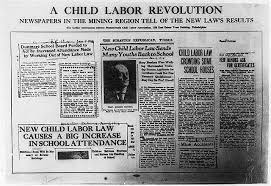
According to Human Rights Watch, over 70 million children around the world work in hazardous conditions in agriculture, mining, domestic labor, and other sectors. Most Americans think this is a problem for other countries.
However, a recent NYT investigation revealed that it’s a significant problem in the United States. Journalists spoke with more than 100 migrant child workers in 20 states who were suffering physically, mentally and emotionally as a result of their work environments. Children are routinely made to work 17-hour days in environments where they are exposed to toxic fumes, excessive noise, and dangerous machinery.
While the dangers and conditions described in the article were shocking, I was most impacted by the resignation I sensed from their comments. “I’m getting used to it”, said one young woman. No one should have to get “used to” these conditions – least of all a child.
International standards classify child labor as a violation of human rights because it prevents children from attending school and limits socio economic mobility. The human rights violations uncovered by the Times reporting go well beyond keeping children out of school and limiting future earning potential. The reporting revealed that companies in the United States are knowingly permitting children to work excessive hours in unsafe work conditions. These companies are third party suppliers to major brands like Frito-Lay, Pepsi, and General Mills.
Failed Government Response
The recent Times’ article makes it clear that the government systems created to protect children and oversee employers have completely collapsed. But these failures are not news – they have been reported for over a decade.
One possible explanation for the failure: the fines and punishments for violating child labor laws are ineffective. Earlier this year, the Department of Labor announced it would assess monetary fines on thirteen employers found to be in violation of child labor laws. An average fine of $118,000 means little to a company whose average annual operating income is over 50 million dollars.
Federal child labor provisions date back to 1938. They were created to protect children’s health, well-being and educational opportunities. What may have been a significant deterrent 85 years ago, does not seem to have the same effect in 2023.
The Department of Labor is not the only federal agency responsible for this situation. The Office of Refugee Resettlement specifically within the Department of Health and Human Services (HHS) is responsible for safeguarding the welfare of unaccompanied minors. The number of undocumented unaccompanied minors has increased since the pandemic began, reaching its peak in 2021. In 2022, nearly 130,000 unaccompanied minors arrived in the United States. There has been widespread reporting about the failures of HHS to manage the volume of undocumented minors.
There are generally three paths forward for an undocumented minor: 1) detention in prison like facilities, 2) release to a family member and 3) release to a sponsor. Approximately 30% have been released to states under sponsorship agreements.
According to policy, HHS is supposed to follow up with these minors released to a sponsor to ensure they are not being trafficked or exploited. The Times article revealed the agency fails to maintain contact with or knowledge of tens of thousands of children, a claim HHS denies. The Times article included interviews with individuals who reported child labor violations to HHS case managers, who demonstrate an unwillingness to investigate the complaints. Both federal agencies cited are understaffed, justifying the lack of action due to a lack of resources necessary to follow up on every child.
Mixed Messages
Days after the Times article was published, the White House announced a series of new initiatives to combat the exploitation of immigrant child labor. This announcement comes at a time when states are easing child labor laws. Iowa law expands the hours and types of jobs children can work while simultaneously limiting employer liability. Minnesota’s new law would allow children aga 16 to work in construction.
Some say labor shortages are behind efforts to loosen child labor laws. I find it mind-bending and shocking that elected officials in America would be willing to place children in harms’ way rather than do the hard work of rectifying the underlying causes of labor shortages.
Some public officials have publicly recognized the need for greater coordination and commitment to protecting children from dangerous working conditions. I agree but think that more is needed. What’s needed are approaches to policy making that are derived from an unwavering conviction that children’s rights should be protected.
Current laws and regulations don’t do enough to protect children from exploitation by employers. The agencies responsible for enforcement aren’t being held accountable for doing their jobs effectively. If nothing changes, America will become a society that not only permits, but perpetuates exploitative child labor practices. I agree with Terri Gerstein; political debates around whether or not 14 year-olds should work in meatpacking factories are outrageous.
A recent study found that adults feel they have a moral imperative to address climate change for future generations. Do we not have a similar moral imperative to protect children from dangerous and exploitative workplaces? The welfare of children determines the future of society, and we will bear the collective responsibility for we do or don’t do in response to the situation uncovered by the Times reporters.
